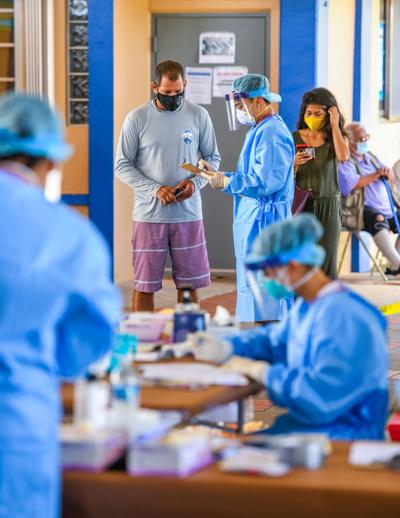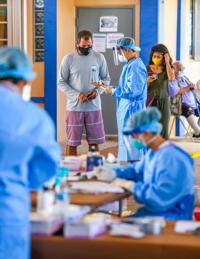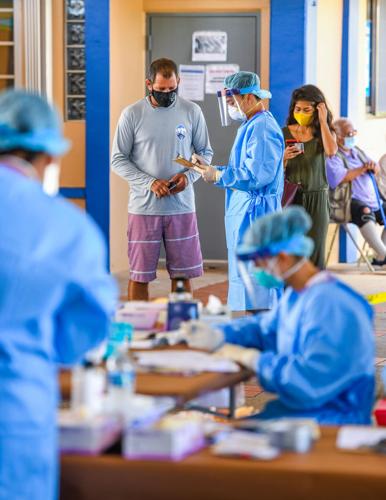Residents coming back to Guam from high-risk areas have more testing options before they arrive to avoid staying at a government quarantine site.
Previously, the Department of Public Health and Social Services was only accepting PCR COVID-19 testing.
However, Public Health is also accepting antigen testing, as well as Abbot ID Now testing, Dr. Janna Manglona said.
More: Cannabis board will add fines to recreational regulations
"The ease of obtaining tests depends upon where you are located," she said.
Serology testing or antibody testing is still not where it needs to be, she added, so Public Health isn't accepting those tests.
According to a Public Health advisory, the COVID-19 tests must be approved by the U.S. Food and Drug Administration and must be presented upon arrival to Guam. The documents must show the name of the patient, date of birth, laboratory or clinic which performed the test, the type of test performed, the date the specimen was collected and the result of the test.
Some places in the states have long wait times for results for PCR tests, which make it difficult to bring back proof of a negative test when coming back to Guam.
Antigen testing and Abbot ID Now testing provides quick results that residents coming back to Guam can use to avoid staying at a government quarantine site.
A PCR test uses a technology called polymerase chain reaction, which greatly amplifies the viral genetic material, if it is present. That material is detectable when a person is actively infected genetic material of the coronavirus. Results from PCR testing can take days or weeks because it needs to be processed in a lab.
Antigen tests can identify viruses in nose and throat secretions. It does this by looking for proteins from the virus as opposed to the PCR test, which looks for genetic material. The antigen test can have results in less than an hour.
Read more: Marsh to agencies: Prioritize mandates, cut costs
Revised guidance
Public Health provided a revised guidance memo July 24 for those arriving from both at risk and low-risk areas for voluntary quarantine.
People coming from an at-risk area without a negative COVID-19 test within five days prior to arrival on Guam will be subject to a 14-day quarantine at a government of Guam facility, the memo states.
They will be directly transported from the airport to the GovGuam quarantine facility and will stay in their rooms.
Residents and visitors will be able to take a test after seven days of quarantine for early release, the memo states. However, they will still be subject to monitoring and tracking up to 14 days.
Those who don't get tested after arrival must complete the 14-day quarantine.
For residents coming from at-risk areas with a negative COVID-19 test result within five days prior to arrival on Guam may self-quarantine. Self-quarantine can also be shortened by taking a COVID-19 test on day seven of quarantine, the memo states, prioritized for those in government quarantine, the Joint Information Center stated.
COVID-19 tests are subject to availability.
For those arriving from low-risk areas and staying for less than five days no quarantine or testing is required. For those staying longer than five days requires a negative COVID-19 test within five days prior to arrival on Guam or take a test post-arrival on day 5.
All persons coming to Guam must comply with daily symptom monitoring and tracking for the duration of stay for up to 14 days.
For those coming from low-risk areas, they must provide a location address, a working phone number, an email address and register on a symptom monitoring app provided by Public Health.
List of low risk areas as of July 24
United States:
- Connecticut
- Maine
- New Hampshire
- New Jersey
- New York
- Vermont
Pacific/Oceania
- American Samoa
- Australia
- CNMI
- FSM
- Marshall Islands
- New Zealand
- Palau
Asia
- Malaysia
- South Korea
- Taiwan
Other countries
- Austria
- Belguim
- Canada
- Denmark
- Finland
- Germany
- Greece
- Hungary
- Iceland
- Ireland
- Italy
- Netherlands
- Norway
- Poland
- Slovakia
- Switzerland
- Spain
- United Kingdom
This article originally appeared on Pacific Daily News: More testing options available for returning travelers to Guam






(0) comments
Welcome to the discussion.
Log In
Keep it Clean. Please avoid obscene, vulgar, lewd, racist or sexually-oriented language.
PLEASE TURN OFF YOUR CAPS LOCK.
Don't Threaten. Threats of harming another person will not be tolerated.
Be Truthful. Don't knowingly lie about anyone or anything.
Be Nice. No racism, sexism or any sort of -ism that is degrading to another person.
Be Proactive. Use the 'Report' link on each comment to let us know of abusive posts.
Share with Us. We'd love to hear eyewitness accounts, the history behind an article.